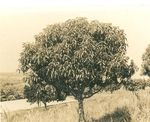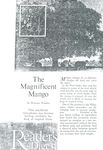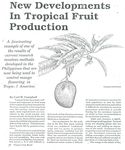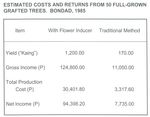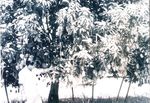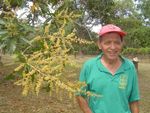Mango Flower Induction Technology - Dr. Ramon C. Barba National Scientist National Academy of Science and Technology (NAST) - NAST Philippines
←
→
Page content transcription
If your browser does not render page correctly, please read the page content below
Mango Flower
Induction
Technology
Dr. Ramon C. Barba
National Scientist
National Academy of Science and Technology (NAST)
Department of Science and Technology (DOST)The Beginning
1957, Start of Interest on
Mango Flower Induction
BSA student, with thesis adviser
* Dr. Leon G. Gonzales*, first to study
“smudging of mango trees (1923)”
Pioneering book,
“Auxins and Plant Growth (1955)”
by *Dr. Aldo Carl Leopold*The Beginning (Cont.) 1958-1960, sustained interest on mango flower induction Assistant Instructor Fruit Crops Section, Dept of Agronomy, UP College of Agriculture (UPCA) Immediate supervisor, thesis adviser, * Dr. Leon G. Gonzales*, first to study “smudging of mango trees (1923)”
The Beginning (Cont.) 1960-1967, postgraduate studies gained more knowledge & ideas on flowering from publications, experiments & interactions with professors & fellow students
The Beginning (Cont.) 1960-1967, postgraduate studies 1962, M.Sc. University of Georgia, USA (Adviser: Dr. Franlin Pokorny) Flowering of azalea using GA & KNO3 New ideas on mechanism of flowering
The Beginning (Cont.)
1960-1967, postgraduate studies
1967, Ph.D. University of Hawaii,
USA
Dr. Toshio Murashige, Adviser
(famous for MS tissue culture medium)
RC Barba, 1st Ph.D. advisee
Modified the technique in sugarcane
single cell isolationThe Beginning (Cont.)
1960-1967, postgraduate studies
Dr. Toshio Murashige,
RC Barba’s adviser
moved to University of
California Riverside
(UCR)
However, RC Barba
did not go with
Dr. Murashige to UCRThe Beginning (Cont.) 1960-1967, postgraduate studies Dr. Roman Romanowski, new adviser endorsed by Dr. Murashige Ph.D. thesis, mechanism of action of herbicide ametrine in banana
The Beginning (Cont.)
1960-1967, postgraduate studies
During Ph.D. at University of Hawaii,
a favorite author of book on
“growth regulators” taught advance
course in “Plant Physiology”
Dr. Aldo Carl Leopold, ProfessorThe Beginning (Cont.)
1967, Warner & Leopold
patented “Ethrel”
Ethrel
(2-chloroethylphosponic acid
Growth regulator that produces
ethylene when sprayed to plant
RC Barba brought back to
UPLB 1 liter of EthrelThe Beginning (Cont.) 1967-’68, Assistant Physiologist, Hawaiian Sugar Planters’ Ass’n (HSPA), Honolulu, Hawaii Pioneered in plantlet regeneration in tissue culture of sugarcane with “Dr. L. G. Nickell”
Challenges to find chemical
flower inducer of mango
1969, back to UP College of
Agriculture (UPCA)
Assistant Professor 1
Fruit Crops Section, Dept. of Agronomy,
UP College of Agriculture (UPCA)
Idea to induce flowering in mango
using chemicalsChallenges to find chemical
flower inducer of mango (Cont.)
1969, back to UP College of
Agriculture (UPCA)
June 1969, Proposal to induce
flowering in mango using ethrel
Chair, Dept. of Agronomy, UPCA
rejected the proposalChallenges to find chemical
flower inducer of mango (Cont.)
Proposal was rejected:
redundant because a PhD exchange
student from Cornell University doing
thesis on mango flowering
mango not assigned crop to conduct
researchChallenges to find chemical
flower inducer of mango
Research on mango flowering was
conducted at a friend’s orchard
on personal capacity
(Saturdays and Sundays):
in private using a PhP 27.00
hand sprayer
10kg KNO3 worth PhP5.00Discovery of Flower Induction
in Mango Using KNO3 @ Quimara Farm
The BreakthroughDiscovery of Flower Induction
in Mango Using KNO3
Personal budget
of PhP500.00
Exploratory test
of several
chemicals on
selected shoots
1% KNO3 induced flowers in 2 weeksDiscovery of Flower Induction
in Mango Using KNO3 (Cont.)
Within 2 weeks, 100 trees, 10 yrs old
& never flowered, were sprayed.
Produced abundant fruits in 4 mos.
Complete technology including field
application & farmers’ adoption in
4.5 mos.Perils of a Commercially
Important Discovery
1971, realization of the perils of the
discovery and innovation
Former Research Assistant (RA), Fruits
Crops Section, Dept of Agronomy,
UPCA, requested to visit Quimara
Farm
RC Barba divulged to the RA the
chemical, where to buy, conc and
method of applicationPerils of a Commercially Important Discovery (Cont.) The Research Assistant (RA), promised not to reveal the discovery without RC Barba’s permission. The RA even requested RC Barba to be his M.Sc. adviser, & the discovery as his thesis. RC Barba expected the RA to respect his discovery, and that the technology was already completed, rejected RA’s proposal to be his M.Sc. thesis.
Perils of a Commercially Important Discovery (Cont.) The Research Assistant (RA), disobeyed his own promise, used the technology without RC Barba’s permission & divulged the discovery to the Department Chair. They tested the technology, claimed the discovery and results published in several publications. Another person applied patent for the mango flower induction technology using same chemical (KNO3).
Patents from the Philippines, USA, Australia, New Zealand, and United Kingdom Never enforced So, free use of technology by growers
“After a rigid selection process, the Philippines was chosen as one of the two countries from the Asia and the Pacific Region for this project. Among many candidates from around the world, you were chosen as one of the individuals to be featured in this documentary.”
Flower induction considered
worldwide- most important
discovery in mango
Flower induction
quickly became
worldwide practice
Generated interest
on research on
flowering
Mexico used it since 1975, 41% share
of world trade FLUSH, a growth enhancer
for tree species (1980)
To speed up growth and advance
fruiting of trees
First used for a 3,000 ha mango
and cashew plantations in the
Magat and Pantabangan
watersheds (1980’s)The Department of Horticulture, CA, UPLB
honored Dr. Ramon C. Barba in 1999 with a
technology award and a citation that
highlighted the impact of his mango flower
induction technology during the 25th
Anniversary of the Department and
the 25th year of the technology.
“The advent of flower induction in mango with potassium nitrate is the single
most important factor that stimulated growth of the industry. Its multiplier effect is
wide and far-reaching benefiting the economic well-being of growers, investors,
pesticide manufacturers, baggers, contractors, kaing-makers, bamboo raisers,
viajeros, truck and jeepney operators, drivers, middlemen, wholesalers, retailers,
exporters, processors, consumers, employers, and employees of mango
establishment among many others. A neglected crop grown for fun, shade, and
shelter before and after the introduction of the technology, yield of mango was 2 and
6 metric tons per hectare, respectively. Whereas few or none existed in the past, by
1995 alone there were at least 174 professional mango contractors, 33 “dried”
mango manufacturers, 105 processed mango products, and about 20 mango
growers associations. These and mango’s contribution to the national economy,
estimated at 7 billion pesos in gross value and 43 million dollars in foreign exchange
earnings, are largely due to the technology unraveled at UPLB”.“The advent of flower induction in
mango with potassium nitrate is the
single most important factor that
stimulated growth of the industry.
‘Its multiplier effect is wide and far-reaching
benefiting the economic well-being of growers,
investors, pesticide manufacturers, baggers,
contractors, kaing-makers, bamboo raisers,
viajeros, truck and jeepney operators, drivers,
middlemen, wholesalers, retailers, exporters,
processors, consumers, employers, and
employees of mango establishment,
among many others.’“A neglected crop grown for fun, shade, and
shelter before and after the introduction of
the technology, yield of mango was 2 and 6
metric tons per hectare, respectively.
Whereas few or none existed in the past, by 1995
alone there were at least 174 professional mango
contractors, 33 “dried” mango manufacturers,
105 processed mango products, and about 20
mango growers associations.
These and mango’s contribution to the national
economy, estimated at 7 billion pesos in gross
value and 43 million dollars in foreign exchange
earnings, are largely due to the technology
unraveled at UPLB”.PHILIPPINE MANGO – AFTER FLOWER
INDUCTION
1. Harvested area increased from
36,000 ha in 1980 to 159,000 ha in
2005, mostly from backyard trees
2. Plantation Development:
1980 – 4,000 ha in Negros, 2,000 ha in
Digos, ECJ
1992 – 4,000 ha in Mindanao, GEM-
USAID
2005 – 100,000 more in Davao and
Cotabato, GEM-USAIDPHILIPPINE MANGO – AFTER
FLOWER INDUCTION (CONT.)
3. Mango contract growing
evolved after 1975
4. Contract growing of individual
5. Plantations, 10-100 ha or more
6. Corporate plantation development –
Conjuangco, Menzi, Consunji,
Benguet Consolidated, Marsman,
othersPHILIPPINE MANGO – AFTER
FLOWER INDUCTION (CONT.)
7. Mango No. 1 in gross value and
GVA in agriculture
No. 2 in export after banana - $60M
4% of fruits exported, mostly from
backyard trees
22% banana exported – mostly from
Corporate FarmsPHILIPPINE MANGO – AFTER
FLOWER INDUCTION (CONT.)
8. Phils, No 2 in world export, 1M tons,
7.8% world share, var ‘Carabao’
9. Mexico # 2, 1.6 million tons, 41% of
world share, variety Manila
10. USA, Australia and China gave grants
to facilitate export of ‘Carabao’
mango to each country
11. Thousands of nurseries were
established.PHILIPPINE MANGO – AFTER
FLOWER INDUCTION (CONT.)
12. Higher business in processing of
various mango products as juice,
dried, fruits, other
13. Big market for production products
as flower inducers (16 brands),
pesticides, insecticide, fertilizer,
machineries, etc.
14. Research generated in public and
private institutions, universitiesMANGO PRODUCTION IN MEXICO:
1. Main variety is “Manila”
2. 1975 – Raul Mosqueda Vasquez,
Mango Leader in Mexico then
Ph.D. student in Hawaii,
requested a copy
3. The M exican Ambassador to
Philippines with Dr. EQJ visited IPB
4. 1980 – Vasquez was in PCARRD.
Mexico since 1975 planted “Manila”
mango on a large scale, 60,000 haMANGO PRODUCTION IN MEXICO:
5. 1986 – Ruben D. Joo Ayar, a
Mexican delegate, in Guatemala
reported:
Mexico plantings in 1975 were then
fruiting
6. 2008 – Ruben D. Joo Ayar and team
with Panfi Tabora visited plantations
in the Phils about ‘Carabao’ mangoMANGO PRODUCTION IN LATIN AMERICA:
1. Barba, Tabora and Mondoñedo
delivered monthly seminars each year
from 1985 to 1990
in Mexico, Guatemala, Honduras,
Costa Rica, Ecuador, Peru and Brazil
sponsored by USAID
2. 21 years later
145,000 ha new hectarage for export
70% share of world trade with value of
1 billion USDMANGO PRODUCTION IN
LATIN AMERICA (Cont)
3. Mexico – 104,000 ha in 1988
increased to183,000 ha in 2007
Volume of 50,000 tons in 1988
increased to 1,600,000 tons in 2003
4. Costa Rica (8,000 ha), Guatemala
(8,000 ha), Nicaragua and Honduras
(3,000 ha)
Harvest advanced to February – April
to avoid peak harvest of Mexico in
MayMANGO PRODUCTION IN
LATIN AMERICA (Cont)
3. Mexico – 104,000 ha in 1988
increased to183,000 ha in 2007
Volume of 50,000 tons in 1988
increased to 1,600,000 tons in 2003
4. Costa Rica (8,000 ha), Guatemala
(8,000 ha), Nicaragua and Honduras
(3,000 ha)
Harvest advanced to February – April
to avoid peak harvest of Mexico in
MayMANGO PRODUCTION IN
LATIN AMERICA (Cont)
5. Peru developed 14,000 ha and
Ecuador some 6,600 ha for export.
6. 1990 – Brazil – Petronila Valley, part of
dry tropics
planted to 20,000 ha
non-existent before 1987
now rivals Mexico.MANGO PRODUCTION IN
LATIN AMERICA (Cont)
7. Hydrothermal plants monitored by
USDA APHIS officers must operate
fully on schedule times
schedule of monitoring from
one country to another,
NOW programmable with KNO3
In these 7 countries – a mix of small,
medium and large plantations get an
income of US$3,000-US$8,000 per ha
- Not possible with natural flowering,
seasonalOther countries that have
favorably used KNO3:
1. Puerto Rico
2. Kenya
3. Australia
4. Hawaii
5. Africa
6. Venezuela
7. Vietnam
8. Latin American countries
9. Southeast AsiaDiscovery of flower induction in mango using KNO3
CURRENT RESEARCHES Somatic
Embryogenesis
in ‘Carabao’
Mango
propagation
conservation
genetic
transformationSomatic Embryogenesis in ‘Carabao’ Mango
PFA Best Poster, 2000 In Vitro Cellular &
Developmental
CSSP Best Paper, 2001 Biology – Plant
PFA Best Paper, 2009 (by Springer)
LBSCFI-PAARFI Outstanding 2002
R&D Award, 2009 2011CURRENT RESEARCHES
Mango Rejuvenation & Flowering
(Del Monte Phils, Inc)AWARDS
National Academy of Science &
Technology (NAST), DOST
Academician, 2004
National Scientist, 2014TOYM (1974)
5 Filipinos break into top 100 Asian scientists list
03:00 PM May 1st, 2016 Leading the Filipino
Five Filipinos were included scientists on the list is
in the maiden “Asian National Scientist
Scientists 100” list released Ramon Cabanos Barba,
recently by The Asian ranked third on the list.
Scientist magazine.
3rd 7th 9th 10th 12thNational Academy of Science & Technology (NAST) - Featured in SALINLAHI, Philippine Heritage Center Flower induction of mango by KNO3 ,,1997 Micropropagation of banana, with LF Pateña & OP Damasco, 1997
Featured in a Booklet “Philippine
Mangoes the Whole Year Round by Dr.
Benito S. Vergara. Philippine Science
Heritage Center, NAST, 1996
Rizal Pro Patria Presidential Award for
Tissue Culture (1980)
IBM/DOST S&T Award (1989)
SEARCA/Dioscoro L. Umali Achievement
Award in Agricultural Development (2011)
World Intellectual Property Office (WPO)
(Switzerland) recognition of technology
(2007)NEW TISSUE CULTURE MEDIUM BP, developed by Barba & Pateña 1. Based on nutrient analysis of tissues 2. Superior to the famous MS medium of Murahige & Skoog for such plants as: mango (PFA Best Poster, 2000; CSSP Best Paper 2001; calamansi & pummelo (CSSP Best Paper Finalist 1978), potato (CSSP Best Paper Finalist, 1992), orchids (PAPTCB 2nd Best Paper, PARRFI Best Research Project 2003) R medium, FCSSP Best Poster Finalist, 2000
Micropropagation and Conservation
HOME l COUNTRIES l WORKSHOPS l MANAGEMENT TEAM l MEETINGS l RESOURCES l ABOUT OSSSU l NEWS
of Philippine Indigenous Orchids M ICROPROPAGATION and
LILIAN F. PATEÑA*, SIMEONA V. SIAR*,
MARY ANN O. CAJANO**,
ALICE B. FORMARAN*, CLAUDETTE N.
C ONSERVATION of I NDIGENOUS
DACUMOS*, AND RAMON C. BARBA*,
Funded by: Dept. for Environment
O RCHIDS in the P HILIPPINES*
Food & Rural Affairs (Defra),
United Kingdom through the
Royal Botanic Gardens, Kew, UK LILIAN F. PATEÑA*, SIMEONA V. SIAR*, MARY ANN O. CAJANO**,
ALICE B. FORMARAN*, CLAUDETTE N. DACUMOS*, AND RAMON C. BARBA*,
Institute of Plant Breeding, Crop Science Cluster
LF PATEÑA SV SIAR College of Agriculture and **Museum of Natural History,
University of the Philippines Los Baños, College, Laguna 4031 Philippines
*Paper presented during the Darwin OSSSU Orchid Seed Conservation
Workshop, 15-19 October 2007, Chengdu, China,
Micropropagation of orchids using
BP (Barba and Patena), formerly R, Medium
BARBA AND PATENA (BP) MEDIUM IS SOLD
COMMERCIALLY. FOR DETAILS:
http://hengduanbiotech.com/showprodinfo.asp?listid=52&cataid=26
http://www.hengduanbiotech.com/showprodinfo.asp?listid=100&cat
aid=31Plant Cell and Tissue Culture Laboratory (PCTCL) Team
2016 College of Agriculture and
UPLB Outstanding Research Team
- One unique attribute of the team is its ability to
perceive solutions to complex problems and to produce
results with minimum expenditure and gadgetry.The Scientist is married to Corazon Veron Cruz and is
now a proud Lolo to 2 year-old grandson, Carlitos,
son of Ricky and Danie Largo Barba
“FAMILY”The Scientist is married to Corazon Veron Cruz
and is now a proud Lolo to 9 year-old grandson,
Carlitos, son of Ricky and Danie Largo Barba
9 year-old grandson, Carlitos,
The future NATIONAL SCIENTISTIt takes a dream to create
a new technology and a
new technology creates
new dreams!You can also read

